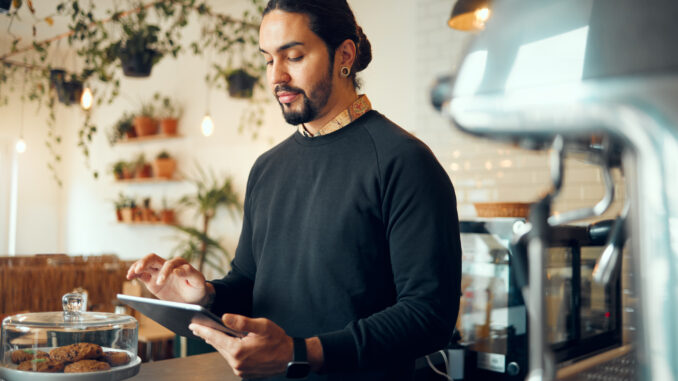
By Zayn King- Dollie, Product Officer, Ordrslip - 5.15.2023
The National Restaurant Association is anticipating a year of growth for foodservice, with a return to pre-pandemic level expected. Restaurants are expected to reach $997 billion in revenue even as staffing issues continue, and many operators are looking at innovative technology to ride this upswing and capture much of this growth without adding employees.
COVID-19 catapulted the adoption of technology to a new high when online ordering and contactless payment became a necessity for doors to stay open. As operations return to pre-pandemic norms, restaurants will need to reevaluate how technology can best benefit their establishment.
Now that operators are adjusting back to pre-pandemic conditions, finding ways to reinvest and streamline operations are becoming a priority. New innovations such as ChatGPT and other AI-powered apps have captured the industry’s interest for their ability to improve customer service and provide quick response times. Operators are now asking if these and other technologies can support revenue growth or if they’re just gimmicks. Understanding the products out on the market — or those already present in restaurants — is time well spent when it comes to discerning what’s beneficial for today’s operations, and what’s not.
Predictive Analytics Can Reduce Waste and Save Money
Predictive analytics are a function of software that can help personalize customers’ experiences through the use of a mix of data analysis, machine learning, AI, and statistical models that together find patterns and predict future behavior. Staff often become familiar with a regular customer’s exact order and can begin to prepare their meal as soon as they walk in. Predictive analytics mimics this behavior on a larger scale for every customer profile after just one order. The software collects historical data and analyzes patterns and trends so restaurants can make data-driven decisions on operations.
This provides a two-fold benefit: it helps operators better understand customer preferences and trends to maximize revenue and customer satisfaction, and it can make predictions based on collected data to help improve inventory ordering so kitchens always have the necessary ingredients for popular dishes on hand. By receiving accurate information, restaurants can better adjust menus and be more precise with food supplies to mitigate food waste, which can make popular items more accessible, increase revenue and improve customer satisfaction.
AI Chatbots – Gimmick or Practical Investment?
AI applications such as ChatGPT have gained popularity by demonstrating how powerful, time-saving AI software can mimic human interactions. Chatbot technology utilizes AI and machine learning to replicate human conversation and provide immediate responses to input questions. With how quickly these applications can provide responses to prompts, operators may be interested in exploring how they could leverage and deploy this technology within their operations. When it comes to customer service, for example, expectations for an immediate answer to questions grew 64 percent year over year, meaning quick responses for customer questions are becoming a growing need for operators.
Chatbots powered by AI can integrate with your phone lines to provide the customer service people are seeking today, making it possible for guests to learn about store hours, the menu, and even make reservations, all without interacting with a live staff. They can streamline the reservation process, which can minimize mistakes and increase customer satisfaction. Integrating new technology into your establishment is a great option, but there’s plenty of opportunity to improve the technologies you already have.
Focusing on Current Technologies
During the pandemic, restaurants needed to rely on tech, like tabletop tablets, online ordering, and contactless payments to offset low staffing and safety concerns. With staff shortages becoming less of an issue today than they were the last few years, there are still uses for these technologies that operators can harness to deliver a higher ROI.
For example, during the lockdowns, mobile ordering spiked and became a highly popular way for people to patronize restaurants at any time of day. That said, many third-party apps come with extra fees for restaurants and customers, which can cut into profits from each individual online order. To get the most out of online ordering, businesses can upgrade their online ordering system through their own website or a third-party app. This gives restaurants more control over mobile ordering and the margins they make from it. If new technologies aren’t in the budget, simply upgrading your current technology can be a practical and profitable option.
Technology has rapidly become a necessity for restaurants looking to optimize profits and operations, across all parts of the business. AI and chatbot technology offer many perks to the industry by taking out human error or the need to increase staff levels, while improving customer service and reducing costs. At the same time, new and existing technologies will need to be carefully examined to see if the solutions are right for their operation and have a true ROI for restaurants.
 Zayn King-Dollie is the Product Officer for Ordrslip, a Bitwise Industries company. Under Zayn’s leadership, the Ordrslip team supports restaurants and coffee shops across the country by providing a streamlined online ordering process. With his strategic vision and years of experience in customer success, Zayn looks to rapidly grow and scale Ordrslip, while creating lasting partnerships with business owners and companies.
Zayn King-Dollie is the Product Officer for Ordrslip, a Bitwise Industries company. Under Zayn’s leadership, the Ordrslip team supports restaurants and coffee shops across the country by providing a streamlined online ordering process. With his strategic vision and years of experience in customer success, Zayn looks to rapidly grow and scale Ordrslip, while creating lasting partnerships with business owners and companies.
Are you an industry thought leader with a point of view on restaurant technology that you would like to share with our readers? If so, we invite you to review our editorial guidelines and submit your article for publishing consideration.

